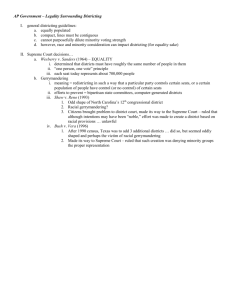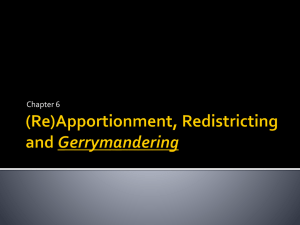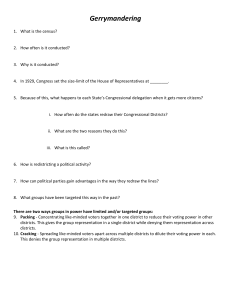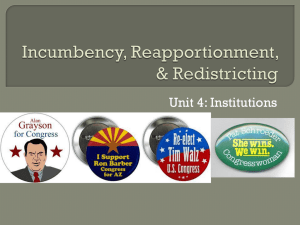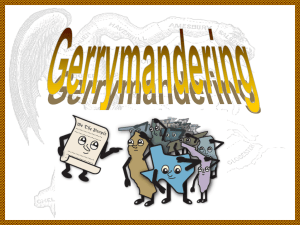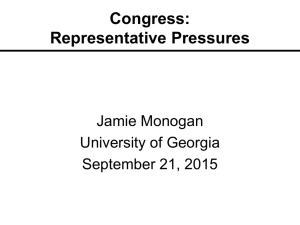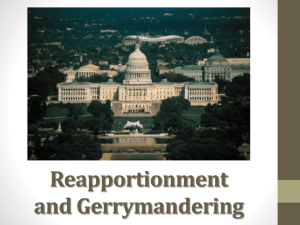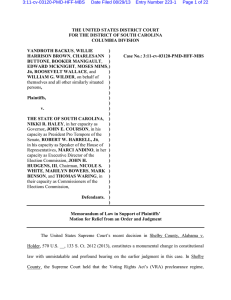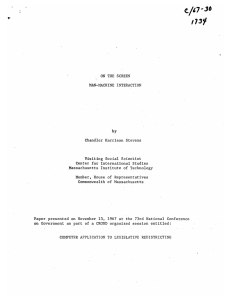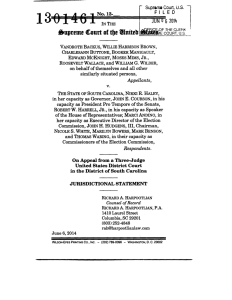View the slides from the lecture
advertisement
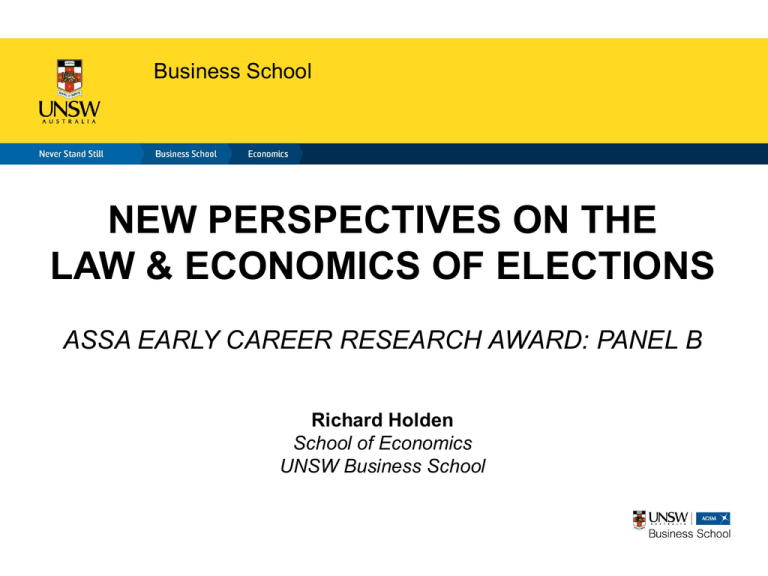
Business School
NEW PERSPECTIVES ON THE
LAW & ECONOMICS OF ELECTIONS
ASSA EARLY CAREER RESEARCH AWARD: PANEL B
Richard Holden
School of Economics
UNSW Business School
BACKDROP
• Long history of political actors seeking to maximize their own
advantage
• Both explains and shapes democratic institutions
• Explosion of “electoral IT”
• Census data,TIGERLine files, GIS
• Individual voter data (browser history, social networks,…)
• Largely in the US? Or coming soon to a democracy near you?
OVERVIEW OF TALK
• Gerrymandering
• Political geography and “compactness”
• Incumbent reelection rate
• Future directions
GERRYMANDERING
GERRYMANDERING
Gerrymander: noun and verb. The action of manipulating the
boundaries of a constituency etc. so as to give advantage at an election
to a party or class. (Oxford English Dictionary)
OPTIMAL STRATEGY FOR
GERRYMANDERER
• What is the optimal strategy?
• What are the implications for representation of
different groups (party, race, gender,…)?
• How can or do regulations/constraints interact?
• You cannot regulate what you don’t understand
OPTIMAL STRATEGY
• Widely-held view: pack and crack
• Pack: group lots of your opponents into a “few” districts
• Crack: spread the remaining voters evenly over the
remaining districts
• Throw away a few districts to win the majority
• Under what conditions/in what settings is this optimal?
• Friedman and Holden (American Economic Review, 2008)
THE PROBLEM
• Voters don’t walk around with D’s and R’s on their foreheads
• A continuum of voter types
• Observe a noisy signal of voting intention
• Form n districts of equal size (Baker v Carr, 1962) to
maximize the expected number of districts won
• Assume that signals satisfy a version of MLRP—higher and
higher signals more and more likely to come from more “rightwing” voters (see Karlin on Total Positivity and Polya
Frequency Functions)
MATCHING SLICES
MATCHING SLICES INTUITION
• Voters in the tails of the distribution v likely to
vote one way or the other
• Best way to use your strongest supporters is to
neutralize your strongest opponents
• Use them as the pivotal voter in some district,
not right/left of the median in many districts
DOES IT ACTUALLY HAPPEN?
IMPLICATIONS
• Suppose Republican redistricter
• If you believe pack-and-crack left tail do “ok”
• Matching slices: they are the worst off
• Which voters are in the left tail?
• Can one ever disentangle partisan and racial
motives in redistricting?!
• Cox and Holden (Chicago Law Review, 2011)
COMPACTNESS
SHAPE OF DISTRICTS
• Lots of oddly-shaped districts
• But how does one measure that?
• SCOTUS cares: “uncouth 28-sided
figure” (Justice O’Connor)
• Fryer and Holden (Journal of Law
and Economics, 2011)
LOTS OF EXISTING MEASURES
• Area of circumscribing figures (rectangle, circle, hexagon, )
• Perimeter length
• Ratio of perimeter length to area of circumscribing figure--call this *
• One minus square root of (*)
• One divided by square root of (*)
• 100 times (*)
• Ratio of district population to area of convex hull of a district
• Ratio of reflexive to non-reflexive interior angles in a district
• Median price of petrol divided by age of oldest citizen in a district…
EXISTING MEASURES
• ad hoc
• Not invariant to
• geographic size
• population and population density
• Want to be able to compare Vermont and Texas
• Also: compactness inherently a property of a districting plan
not a district—can’t change one district without changing at
least on other
OUR APPROACH
• 3 axioms a reasonable districting plan should satisfy
• Anonymity: treat all voters equally
• Invariance: not depend on number of districts, size, or
population density
• Clustering: all else equal, greater total intradistrict
distances means less compactness
• Propose an index satisfying these properties: the Relative
Proximity Index
THE RPI
• Numerator: sum over pairwise squared distance b/w all
voters in a given district, then sum over all districts
• Denominator: the same sum but in the partition that
minimizes the sum
• Theorem: any index that satisfies the 3 axioms ranks
districting plans identically to the RPI
A SIMPLE EXAMPLE
•
•
•
•
Numerator=24
Min partition = {{1,2,5},{3,5,6}}
Denominator=16
RPI=24/16=3/2
COMPUTING THE MIN
• Minimum partition problem is NP-Hard
• CA: n=53, census tracts=6,800
• Number of possible districting plans
CA=78.4x1059,351
• Even in a small state number of plans great than
number of atoms in the visible universe
POWER DIAGRAMS
• Optimally compact districts are
power diagrams
• Power diagrams used in
tropical geometry, string
theory, image processing
• Kind of a generalization of
Voronoi diagrams
• Develop an efficient algorithm
to find them using US censustract-level data
COMPACT DISTRICTS
COMPACT DISTRICTS
ELECTION
COUNTERFACTUALS
•
Would also be nice to say something about what elections would look like under
the alternative districts
•
Estimate the seats-votes curve
•
•
A mapping from proportion of votes to number of seats in legislature
•
Biasdness: How many seats does party A win if they get half the votes
•
Responsiveness: derivative of the SV curve (at a point, eg. 50 percent)—
majoritarian v. pro v. counter
Use Gelman-King (1994) method
•
Bayesian approach
•
Linear model with idiosyncratic and systematic error components
CA ELECTION
COUNTERFACTUALS
ELECTION
COUNTERFACTUALS
INCUMBENT REELECTION
US HOUSE OF REPS
REELECTION RATE
GERRYMANDERING DID IT?
•
“Bipartisan gerrymandering is emerging as a new, equally serious but
different kind of threat to American democracy. Congressional elections in
the wake of the 2000 round of redistricting were the least competitive of
any general elections in United States history, with redistricting a central
reason...Bipartisan gerrymanders increasingly make election day for
representative bodies an empty ritual.” Pildes (2002)
•
“And it is the yawning gap between the huge problems our country faces
today -- Social Security reform, health care, education, climate change,
energy -- and the tiny, fragile mandates that our democracy seems able to
generate to address these problems that is really worrying. Why is this
happening? Clearly, the way voting districts have been gerrymandered in
America...is a big part of the problem. “ Thomas L. Friedman, Thou Shalt
Not Destroy the Center, New York Times, November 11, 2005.
A USEFUL FACT
•
Redistricting happens (essentially) every 10 years and
only every 10 years—after the decennial census
•
Money, media, etc happen all the time
•
So, fit a flexible smooth function to the data (cubic spline
or high-order polynomial) and leave a step function behind
that can only move at 1952, 1962,…,2002,…
•
If gerrymandering did it, then expect steps up
•
Friedman and Holden (Journal of Politics, 2009)
THE EVIDENCE
LEVELS VERSUS CHANGES
• Changes in incumbent reelection rate not due
to redistricting
• But ingoing level was pretty high
• Timing of downward steps in our analysis
suggest constraints of VRA important
IF NOT THAT THEN WHAT?
•
Polarization? (McCarty-Poole-Rosenthal say no)
•
Political geography? (Glaeser)
•
Money in politics?
•
Media?
•
Two-sided matching?
CURRENT AND FUTURE
DIRECTIONS
CURRENT AND FUTURE
DIRECTIONS
•
Political geography meets redistricting (e.g. Chen-Rodden)
•
Algorithmic redistricting (e.g. Fifield-Higgins-Imai)
•
Voter turnout
•
Term limits—or fancier versions thereof
•
Partially orthogonal: primaries and parties (e.g. HoldenHummel, Journal of Public Economics 2014)
JUST THE US? OR COMING SOON
TO A DEMOCRACY NEAR YOU?
• Geography-free fact: politicians are self-interested actors
• Lots of the stuff I’ve talked about doesn’t happen in Australia
• Institutions (and conventions) matter
• US: states determine election law; remedies largely under
Equal Protection Clause of 14th Amendment
• Aus: different federal structure, but…
• Might change?
• Different constitutional structure vis a vis these issues

